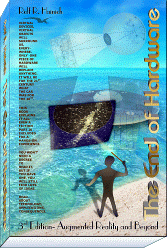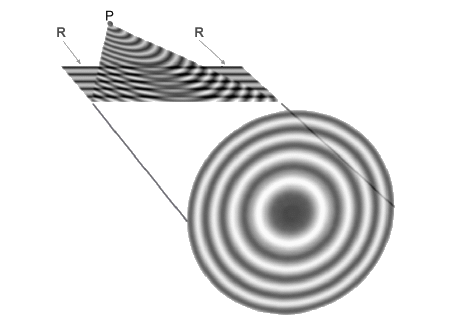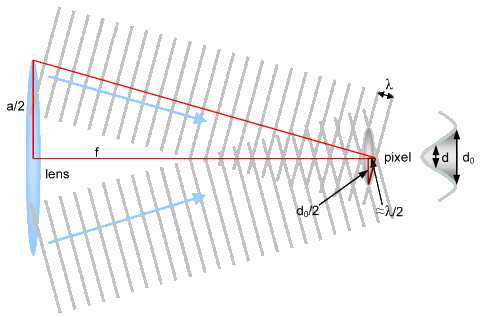Augmented Reality is more than Virtual Reality
Holographic encoding illustrated
Pixels (p) of a scenery lit with laser light will emit spherical light waves. If we overlay these with a planar wave front (R), we get interference patterns that on a photo plate placed in front of the scene will form concentrical ring patterns. Such a ring pattern for one point is called a zone plate or a fringelet. If we develop the photo and light the fringelet with a planar wave front again, any bright part of it acts as a wave origin emitting a spherical wave front and all wave fronts overlay to form the original wave front from the point P again. The fringelet acts like a lens. A complete hologram consists of many overlaid fringelets that each encode different pixels of an entire scene. It's the most astonishing fact about holography that this overlaying really works, although the combined interference patterns of a hologram look chaotic to the naked eye.
Practical hologram photography uses a little more complicated setups, with a spherical reference front (R) for example, but that's not decisive for our considerations. What is important, that gray values have to be reproduced perfectly, otherwise a crisp picture can't be achieved. Instead of gray values. It should be noted that areas of differnt refraction index can be used for the same effect, phase shifting light instead of dimming it, hence without causing loss.
The actual resolution of a hologram can be derived if we just regard a single zone plate or lens emitting coherent wave fronts from its borders. for large f, we approximately get
(do/2)/(/2) = f/(a/2), hence approx. d = f *
/a, as do only denotes the zero points of a sinusoidal intensity distribution, so the actual pixel diameter d is smaller, dependent on the contrast desired (this formula also determines how well a laser beam of given diameter a can be focused at all, and inverted it gives the inevitable deviation of a laser beam of diameter d).
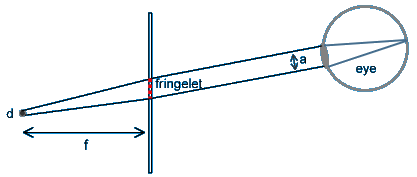
The lens size (aperture) of the human eye limits the resolution that can be seen in a hologram. With light waves, this results in resolution of just 1/4 millimeter for example, even though the hologram contains data for below 1 micrometer. Hence, the hologram has a huge lot of superfluous patterns that don't contribute to the actual picture seen (redundancy).
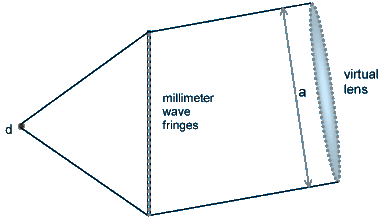
A virtual millimeter wave hologram can also encode entire scenes with good resolution. Decoding it is best done with a virtual lens of about screen size. A hologram wavelength of 0.5mm could encode a resolution of also approx. 0.5mm, enough for a large screen. Hence, this type of hologram does not require many more pixels than a conventional picture.
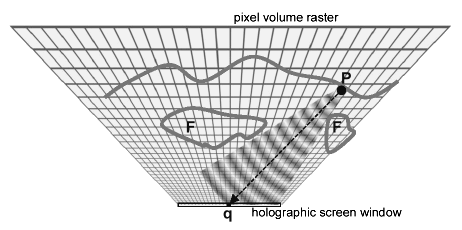
Encoding a synthetical hologram can be done pixel by pixel, based on a raster that expands with distance. Distant pixels can be larger, as they merge by natural blurring. In principle, we could just simply compute the interferences of all pixel wave fronts (although this incurs a lot of calculations and some more sophisticated methods would be appreciated). Some disadvantages of natural hologram photography, like self interference from pixels lighting other pixels indirectly, fortunately don't occur here anyway. Some sophisticated improvements like the diffraction optimized approach [65] are also available in synthetic holography only.
Background pixels only visible through gaps between foreground objects (F) are encoded in parts of the window only, resulting in a smaller effective aperture (a) and less resolution. It's perfectly possible to compensate for this, by encoding such pixels with a smaller wavelength.
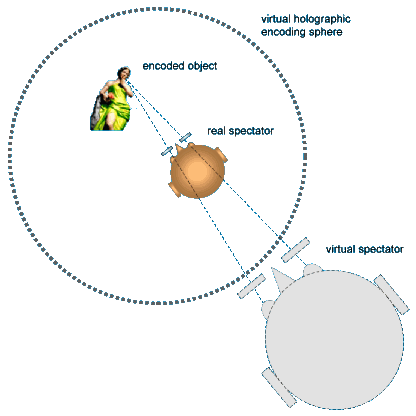
Immersive or 'holodeck' like media or game productions may be encoded on a virtual holographic sphere instead of a flat window.
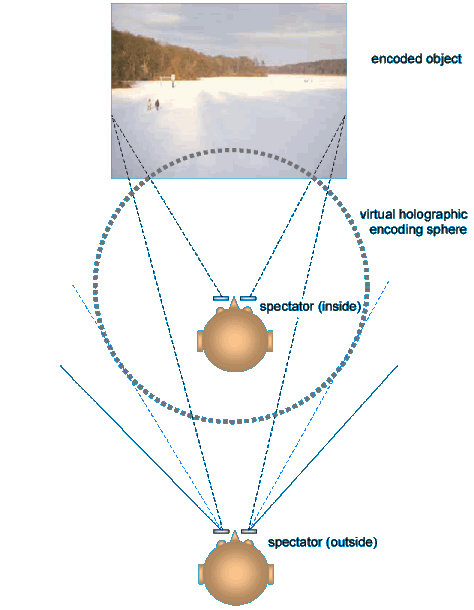
Scenes may be encoded in one or more layers inside and/or outside a virtual sphere and spectators can be positioned inside and/or outside as desired.
home more notes order
Copyright © 2006-2011 Rolf R. Hainich; all materials on this website are copyrighted.
Disclaimer: All proprietary names and product names mentioned are trademarks or registered trademarks of their respective owners. We do not imply that any of the technologies or ideas described or mentioned herein are free of patent or other rights of ourselves or others. We do also not take any responsibility or guarantee for the correctness or legal status of any information in this book or this website or any documents or links mentioned herein and do not encourage or recommend any use of it. You may use the information presented herein at your own risk and responsibility only. To the best of our knowledge and belief no trademark or copyright infringement exists in these materials. In the fiction part of the book, the sketches, and anything printed in special typefaces, names, companies, cities, and countries are used fictitiously for the purpose of illustrating examples, and any resemblance to actual persons, living or dead, organizations, business establishments, events, or locales is entirely coincidental. If you have any questions or objections, please contact us immediately. "We" in all above terms comprises the publisher as well as the author. If you intend to use any of the ideas mentioned in the book or this website, please do your own research and patent research and contact the author.
